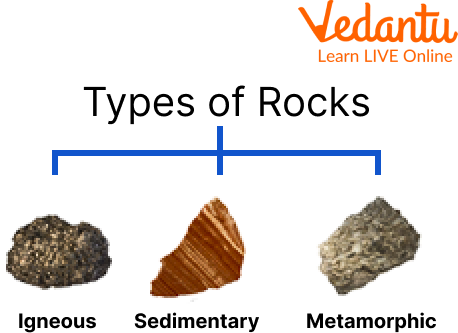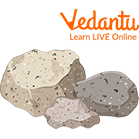




Overview of Igneous Rocks
Natural rock formation occurs when microscopic grains of various minerals are squeezed by external pressure. Different types of rocks form via different processes. The buildup or deposition of mineral or organic particles on the surface of the Earth creates sedimentary rocks. Metamorphic rocks are created when watery hot fluids are subjected to high heat and pressure. Igneous rocks are created when lava cools and solidifies. Let's explore the development of igneous rocks and some interesting information on igneous rocks information in detail in this article.
What are Rocks?
The qualities of all the mineral traces combine to form rocks, which are mineral aggregates. Any particular arrangement of chemical composition, mineralogy, grain size, texture, or other distinctive qualities can be used to classify different types of rocks. Every significant form of rock also has a different classification system. Rocks come in a variety of varieties in the natural world.
Natural rocks are rarely encountered with such basic features, and they typically display some fluctuation in the set of attributes as the measurement scale shifts.
Types of Rocks
There are three types of rocks:
Igneous Rocks are formed as magma cools and solidifies below the Earth's surface. For example, granite, basalt, sandstone and limestone.
Sedimentary Rocks are formed when mineral-rich and organic-rich sediments are deposited by water, wind, or ice. Metamorphic Rocks: They are a type of rock that forms from the merging, crushing and heating preexisting rocks. For example, gneiss and marble.

Types of Rocks
Out of these three, we will focus on Igneous Rocks.
What are Igneous Rocks?
According to the definitions, igneous rocks are rocks created when molten rock, or rock that has been liquefied by extreme heat and pressure, cools to a solid condition. The molten rock known as lava flows from cracks or vents at volcanic centres (when cooled, they form rocks such as basalt, rhyolite, or obsidian). Pyroclastic deposits are collections of broken rock ejected during volcanic eruptions, such as ash, bombs, tuffs, and volcanic breccias. They are referred to as primary rocks since igneous rocks are created from magma and start the rock cycle.

Igneous Rocks
Rocks that are igneous can be recognised by their texture, density, colour, and mineral makeup. Its texture is influenced by the rock's size, form, cooling and solidification process, and crystallinity distribution.
Igneous Rock Examples
Specifications of Igneous Rocks
The specifications of Igneous Rocks are as follows:
There are no fossil deposits in igneous rock types. If there are any fossils present deep inside the crust, they are destroyed when these rocks erupt from the Earth's surface because of the extreme heat they generate.
The majority of igneous formations have several mineral deposits.
They can be gritty or glassy.
Normally, they don't react with acids.
The mineral deposits come in the shape of different-sized patches.
Types of Igneous Rock
According to the lava they cool from, igneous rocks can have varying compositions and appearances depending on the cooling conditions. Extrusive and intrusive rocks are the two primary subcategories of igneous rocks.
Intrusive Igneous Rock
Intrusive igneous rocks form huge crystals as the earth progressively cools and crystallises beneath the surface. Intrusive igneous rocks include pegmatite, granite, and diorite, for instance.
Extrusive Igneous Rock
Extrusive igneous rocks erupt onto the surface and immediately cool, forming tiny crystals. A few rocks cool so quickly that they turn into an amorphous glass. Some examples of extrusive igneous rock are basalt, tuff, and pumice.
Facts About Igneous Rocks
Observe fascinating igneous rock facts. Discover intriguing details and various illustrations that help define igneous rocks and highlight how they differ from other types of rocks.
Magma cools and solidifies, either above or below the Earth's surface, to form igneous rock.
During volcanic eruptions, magma can be driven into rocks or forced to the surface as lava.
Magma is made up of the atoms and molecules of melted minerals.
As the lava cools, these atoms and molecules rearrange themselves into mineral grains, which coalesce to form rock.
Igneous rocks come in approximately 700 different varieties.
Basalt, granite, pumice, obsidian, tuff, diorite, gabbro, and andesite are igneous rocks.
Granulite is a metamorphic rock formed when basalt is exposed to intense heat and pressure over time (metamorphism).
Granite is a typical rock with at least 25% quartz occasionally utilised in building due to its strength.
When molten rock is suddenly thrown out of a volcano, bubbles occur as the rock rapidly loses pressure and cools simultaneously. This unique, light rock is called pumice.
Obsidian is a volcanic glass that crystallises swiftly and spontaneously; because of its potentially razor-sharp edges, it can be used as an arrowhead or cutting instrument.
A rock called tuff is created from volcanic ash.
About 95% of the Earth's crust's upper layer is formed of igneous rock.
Summary
In this article, we learned that igneous rocks, which can include a variety of crystalline or glassy noncrystalline rocks, are created when molten earth material cools and solidifies (magma). One of the three main kinds of rocks is igneous rocks, the other being metamorphic and sedimentary rocks. Most igneous rocks are composed of quartz, feldspar, pyroxenes, amphiboles, micas, olivines, nepheline, leucite, and apatite, even though their compositions vary greatly. Rocks can be characterised as either extrusive or intrusive. We hope you enjoyed reading this article. In case of any other doubts, feel free to ask in the comments.
FAQs on Igneous Rocks
1. Why are fundamental rocks referred to as igneous rocks?
Primary rocks are igneous rocks because they are created from magma and are the first in the rock cycle.
2. Which kind of igneous rock is most typical?
The most typical igneous rock is basalt. Basalt makes up the majority of the ocean floor.
3. How can you tell the age of a rock from its composition?
The amount of time it takes for a rock to produce the ingredients that make up its composition determines its age.
4. Where are some places where geologists have found continental-scale igneous rocks?
Australia, North America, South America and Africa have been sites where continental-scale igneous rocks have been found.









